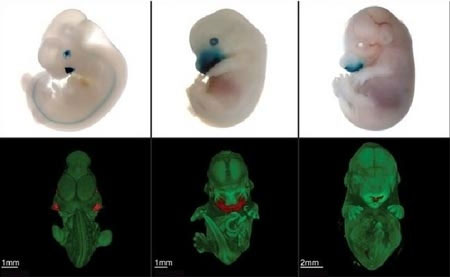DNA identification determines facial shape
The face shape is primarily determined by the gene, but no two faces are exactly the same. How does the gene help create faces with minor differences while still avoiding serious disfigurement or facial deformities such as cleft lip and cleft palate? The answer may lie in "junk DNA" , according to a new US study.
Noncoding DNA , sometimes called junk DNA , is a sequence of genes that do not produce proteins and some of them are thought to have no known biological functions.

Researchers at the Lawrence Berkeley Laboratory have identified remote-controlled gene sequences that determine the face shape in mice.Red areas indicate the area of activity of a gene.
Through mouse studies, scientists from Lawrence Berkeley National Laboratory (USA) have identified more than 4,000 small regions in the genome that are likely to be a form of non-coding DNA , enhancing the expression of a gene. . These regions have been active in the development of the face of a mouse embryo.
Most of these enhanced gene sequences also exist in humans. Therefore, they are more likely to have similar face shaping functions.
To test whether the enhanced gene sequences actually determine face shape, the team removed three of them in mice and compared them with normal mice at 8 weeks of age. The results showed that each enhanced gene sequence was removed, leading to a noticeable difference in facial shape, such as increasing or decreasing the length of the face or the width of different parts of the face such as the skull base. or frog.
In the study, to avoid the challenge of identifying specific mouse faces, the researchers created 3D images using a process called microscopic tomography to attach changes to mold shapes. face with changes in the function of each enhanced gene sequence. Identifying "junk DNA" that regulates the activity of a gene is also difficult, because they are not necessarily next to the target gene, but can "get out" from further locations in the genome.
Scientists have identified many genetic defects that lead to facial defects such as cleft palate or cleft palate, but only a few genes have been found to be involved in normal changes in face shape. Researching genes that regulate facial shape changes may help geneticists have a chance to look for special mutations in the enhanced gene sequence, which can affect birth defects in humans.
- Identification technology is going to be widely applied
- Australia will drop the passport, switch to face recognition at the airport
- How to deal with facial allergies
- Getting sick through each position on the face
- Facial recognition system $ 1 billion
- The shape of your chin tells you more than you think
- Infrared sensor controls the device with facial features
- China develops human identification technology through gestures
- The robbers are captured by facial recognition technology
- Detect bored students with identification technology
- Differences in facial expressions at pain and ... orgasm between cultures
- Identify 5 genes that regulate face shapes
 Green tea cleans teeth better than mouthwash?
Green tea cleans teeth better than mouthwash? Death kiss: This is why you should not let anyone kiss your baby's lips
Death kiss: This is why you should not let anyone kiss your baby's lips What is salmonellosis?
What is salmonellosis? Caution should be exercised when using aloe vera through eating and drinking
Caution should be exercised when using aloe vera through eating and drinking